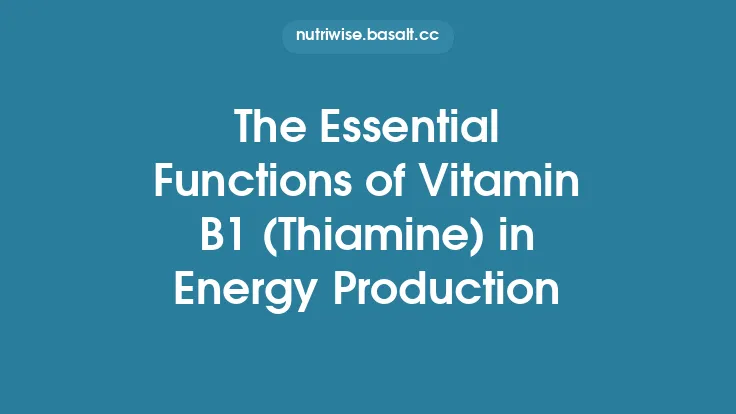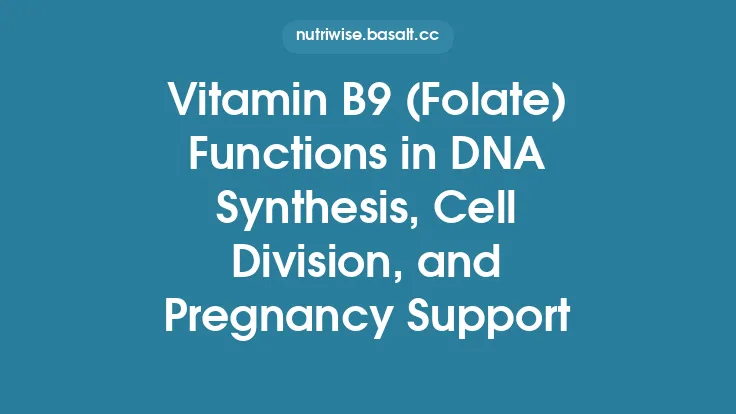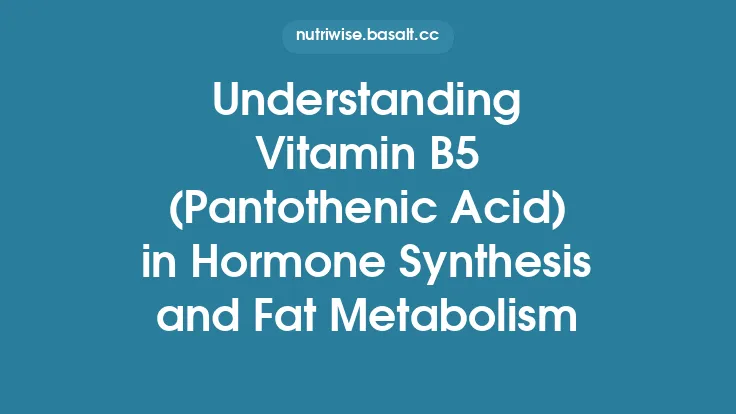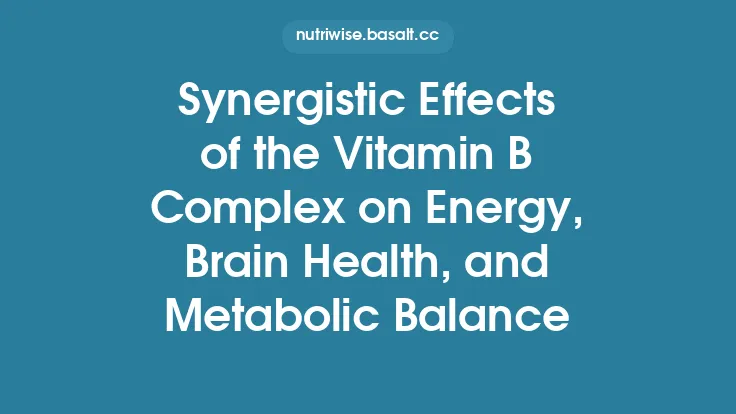Vitamin B6, known chemically as pyridoxine, is a water‑soluble micronutrient that serves as a versatile cofactor in a multitude of enzymatic reactions throughout the body. Its most celebrated roles involve the synthesis of neurotransmitters that regulate mood, cognition, and motor function, as well as the metabolism of amino acids that provide the building blocks for proteins, hormones, and other bioactive molecules. Because the brain and the immune system rely heavily on these pathways, maintaining adequate pyridoxine status is essential for neurological health, metabolic balance, and overall physiological resilience.
Chemical Structure and Biologically Active Forms
Pyridoxine, pyridoxal, and pyridoxamine are the three interconvertible vitamers that constitute the vitamin B6 family. In the body, each is phosphorylated by pyridoxal kinase to yield the active coenzyme pyridoxal‑5′‑phosphate (PLP). PLP is the form that binds to enzyme active sites, stabilizing carbanionic intermediates and facilitating a wide range of reactions, including decarboxylation, transamination, racemization, and β‑elimination. The structural hallmark of PLP is its aldehyde group, which forms a Schiff base (internal aldimine) with the ε‑amino group of a lysine residue in the enzyme. This covalent linkage creates an electron‑sink that stabilizes reaction intermediates, allowing otherwise energetically unfavorable transformations to proceed under physiological conditions.
Absorption, Transport, and Cellular Distribution
Dietary vitamin B6 is absorbed primarily in the jejunum via a sodium‑dependent carrier mediated by the proton‑coupled folate transporter (PCFT) and the sodium‑dependent multivitamin transporter (SMVT). Once inside enterocytes, the three vitamers are rapidly phosphorylated to PLP or converted to pyridoxal, which is then bound to albumin for transport through the portal circulation. The liver plays a central role in regulating plasma PLP concentrations, releasing the coenzyme bound to albumin or, in the case of excess intake, converting it to 4‑pyridoxic acid for renal excretion.
Within cells, PLP is released from albumin by the action of alkaline phosphatases and is taken up by mitochondria and cytosol where it associates with specific PLP‑dependent enzymes. Because PLP is water‑soluble and cannot be stored in large quantities, a continuous dietary supply is required to sustain its myriad functions.
Role in Neurotransmitter Synthesis
1. Serotonin Production
The conversion of the essential amino acid tryptophan to serotonin (5‑hydroxytryptamine) proceeds through two PLP‑dependent steps. First, tryptophan is hydroxylated by tryptophan hydroxylase to 5‑hydroxytryptophan. The second step, catalyzed by aromatic L‑amino acid decarboxylase (AADC), requires PLP to decarboxylate 5‑hydroxytryptophan into serotonin. Adequate PLP levels thus directly influence central and peripheral serotonin concentrations, affecting mood regulation, sleep, appetite, and gastrointestinal motility.
2. Dopamine, Norepinephrine, and Epinephrine Pathway
Tyrosine is converted to L‑DOPA by tyrosine hydroxylase, a reaction that does not require PLP. However, the subsequent decarboxylation of L‑DOPA to dopamine is PLP‑dependent, again mediated by AADC. Dopamine β‑hydroxylase, which converts dopamine to norepinephrine, does not require PLP, but the final methylation of norepinephrine to epinephrine (catalyzed by phenylethanolamine N‑methyltransferase) is indirectly supported by PLP through its role in maintaining adequate SAMe (S‑adenosyl‑methionine) levels. Consequently, PLP deficiency can lead to reduced catecholamine synthesis, manifesting as fatigue, depression, and impaired stress responses.
3. γ‑Aminobutyric Acid (GABA) Formation
Glutamate decarboxylase (GAD) is a PLP‑dependent enzyme that converts the excitatory neurotransmitter glutamate into the inhibitory neurotransmitter GABA. GABA is the principal inhibitory signal in the central nervous system, modulating neuronal excitability, preventing seizures, and contributing to anxiolytic effects. PLP deficiency diminishes GAD activity, potentially lowering GABA concentrations and predisposing individuals to anxiety, irritability, and seizure susceptibility.
4. Histamine Metabolism
Histidine decarboxylase, another PLP‑dependent enzyme, converts histidine to histamine, a biogenic amine involved in immune responses, gastric acid secretion, and neurotransmission. While excess histamine can provoke allergic reactions, balanced production is essential for normal physiological signaling.
Amino Acid Metabolism and Transamination
1. Transamination Reactions
PLP serves as a coenzyme for the aminotransferase family, which transfers amino groups between amino acids and α‑keto acids. Key enzymes include alanine aminotransferase (ALT), aspartate aminotransferase (AST), and branched‑chain aminotransferase (BCAT). These reactions are pivotal for:
- Nitrogen Balance: Facilitating the removal of excess nitrogen via the urea cycle.
- Gluconeogenesis: Providing substrates such as alanine for hepatic glucose production during fasting.
- Energy Production: Enabling the catabolism of glucogenic and ketogenic amino acids for entry into the citric acid cycle.
2. Decarboxylation of Amino Acids
Beyond neurotransmitter synthesis, PLP‑dependent decarboxylases convert several amino acids into biologically active amines. For example, the decarboxylation of lysine yields cadaverine, while the decarboxylation of ornithine produces putrescine, both of which are polyamines involved in cell proliferation and tissue repair.
3. Racemization and β‑Elimination
PLP catalyzes the interconversion of L‑ and D‑amino acids (racemization) and the removal of β‑hydroxyl groups (β‑elimination). These reactions are essential for the metabolism of certain non‑proteinogenic amino acids and for the detoxification of potentially harmful metabolites.
4. Synthesis of Heme Precursors
δ‑Aminolevulinic acid synthase (ALAS), the rate‑limiting enzyme in heme biosynthesis, requires PLP to condense glycine and succinyl‑CoA into δ‑aminolevulinic acid (ALA). Adequate PLP thus supports hemoglobin formation and the function of cytochromes involved in oxidative phosphorylation.
Cofactor Functions in Enzyme Catalysis
PLP’s unique ability to form a Schiff base with substrate amino groups creates an electron‑delocalized intermediate known as a quinonoid complex. This complex stabilizes carbanionic transition states, lowering activation energy for reactions that would otherwise be thermodynamically unfavorable. The versatility of PLP allows it to participate in:
- Decarboxylation: Removal of carboxyl groups from amino acids (e.g., AADC, GAD).
- Transamination: Transfer of amino groups between donors and acceptors (e.g., ALT, AST).
- Elimination and Replacement: β‑Elimination of leaving groups and subsequent replacement (e.g., cystathionine β‑synthase in the transsulfuration pathway).
- Racemization: Interconversion of stereoisomers (e.g., alanine racemase in bacterial cell wall synthesis, though not a human pathway, illustrates PLP’s broad catalytic scope).
Because PLP is required for over 140 distinct enzymatic activities, its deficiency can have cascading effects across metabolic networks.
Clinical Implications of Deficiency and Toxicity
Deficiency
- Neurological Manifestations: Peripheral neuropathy, irritability, depression, seizures, and impaired cognition are hallmarks of insufficient PLP, reflecting compromised neurotransmitter synthesis.
- Hematologic Effects: Reduced heme synthesis can lead to microcytic anemia, while impaired amino acid metabolism may cause elevated plasma homocysteine, a risk factor for cardiovascular disease.
- Immune Dysregulation: Lowered production of cytokines and impaired lymphocyte proliferation have been observed in PLP‑deficient states.
- Pregnancy Concerns: Adequate vitamin B6 is crucial for fetal brain development and for mitigating nausea and vomiting (hyperemesis gravidarum).
Risk groups include individuals with malabsorption syndromes (celiac disease, inflammatory bowel disease), chronic alcoholism, elderly populations, and those on certain medications (e.g., isoniazid, penicillamine) that increase PLP excretion.
Toxicity
Vitamin B6 toxicity is rare but can occur with prolonged high‑dose supplementation (>200 mg/day). The primary manifestation is sensory neuropathy characterized by numbness, tingling, and ataxia, which may be irreversible if the excess intake is not discontinued promptly. The tolerable upper intake level (UL) for adults is set at 100 mg/day to prevent such adverse effects.
Dietary Sources and Recommended Intakes
Rich Food Sources
| Food Item | Approx. PLP (µg) per 100 g |
|---|---|
| Chickpeas (cooked) | 0.5 mg |
| Salmon (wild) | 0.9 mg |
| Bananas | 0.4 mg |
| Sunflower seeds | 1.3 mg |
| Beef liver | 0.9 mg |
| Fortified cereals | 0.5–1.0 mg |
Recommended Dietary Allowance (RDA) (U.S. Institute of Medicine)
| Age Group | RDA (mg/day) |
|---|---|
| Infants 0–6 mo | 0.1 |
| Infants 7–12 mo | 0.3 |
| Children 1–3 yr | 0.5 |
| Children 4–8 yr | 0.6 |
| Children 9–13 yr | 1.0 |
| Adolescents 14–18 yr (male) | 1.3 |
| Adolescents 14–18 yr (female) | 1.2 |
| Adults (male) | 1.3 |
| Adults (female) | 1.2 |
| Pregnancy | 1.9 |
| Lactation | 2.0 |
These values reflect the amount needed to maintain plasma PLP concentrations sufficient for optimal enzymatic activity.
Interactions with Medications and Other Nutrients
- Isoniazid (INH): A first‑line anti‑tuberculosis drug that forms a hydrazone with PLP, accelerating its urinary loss and precipitating deficiency. Co‑administration of pyridoxine (typically 25–50 mg) is standard prophylaxis.
- Oral Contraceptives: May increase plasma PLP turnover, potentially raising the dietary requirement.
- Levodopa (L‑DOPA) Therapy: PLP is required for the decarboxylation of L‑DOPA to dopamine. However, peripheral conversion can reduce central availability; thus, peripheral dopa‑decarboxylase inhibitors (e.g., carbidopa) are used to preserve central dopamine synthesis.
- Vitamin C and B12: High doses of vitamin C can degrade PLP in vitro, but clinical relevance is minimal. Adequate vitamin B12 status supports homocysteine remethylation, a pathway that shares substrates with PLP‑dependent transsulfuration, highlighting the interdependence of B‑vitamin pathways.
Practical Recommendations for Optimizing Vitamin B6 Status
- Consume a Balanced Diet: Incorporate a variety of PLP‑rich foods daily—legumes, nuts, fish, poultry, and whole grains—to meet the RDA without reliance on supplements.
- Mind Medication Interactions: If you are prescribed isoniazid, penicillamine, or certain anticonvulsants, discuss pyridoxine supplementation with your healthcare provider.
- Avoid Excessive Supplementation: Unless medically indicated, stay below the UL of 100 mg/day. For therapeutic purposes (e.g., managing nausea in pregnancy), short‑term dosing under professional guidance is advisable.
- Monitor Neurological Symptoms: Early signs of deficiency (tingling, mood changes) warrant dietary review and possibly plasma PLP testing.
- Consider Life‑Stage Adjustments: Pregnant, lactating, and elderly individuals have higher requirements; plan meals accordingly or use prenatal vitamins that contain appropriate B6 levels.
- Synergize with Other Nutrients: Ensure adequate intake of folate, B12, and methionine to support interconnected one‑carbon metabolism and homocysteine clearance.
By appreciating the centrality of pyridoxal‑5′‑phosphate in neurotransmitter biosynthesis and amino acid metabolism, health professionals and informed consumers can make evidence‑based choices that safeguard neurological function, metabolic health, and overall vitality. Regular intake of vitamin B6 through a diverse diet, coupled with awareness of drug‑nutrient interactions, remains the most reliable strategy for maintaining optimal PLP status throughout the lifespan.





